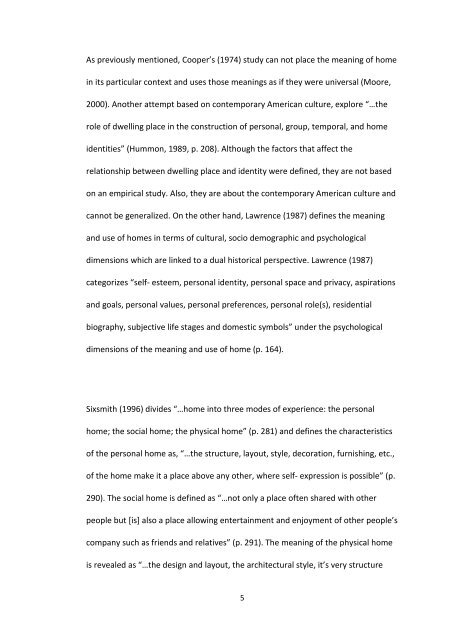private and public use of the living room - Bilkent University
private and public use of the living room - Bilkent University
private and public use of the living room - Bilkent University
Create successful ePaper yourself
Turn your PDF publications into a flip-book with our unique Google optimized e-Paper software.
As previously mentioned, Cooper’s (1974) study can not place <strong>the</strong> meaning <strong>of</strong> home<br />
in its particular context <strong>and</strong> <strong>use</strong>s those meanings as if <strong>the</strong>y were universal (Moore,<br />
2000). Ano<strong>the</strong>r attempt based on contemporary American culture, explore “…<strong>the</strong><br />
role <strong>of</strong> dwelling place in <strong>the</strong> construction <strong>of</strong> personal, group, temporal, <strong>and</strong> home<br />
identities” (Hummon, 1989, p. 208). Although <strong>the</strong> factors that affect <strong>the</strong><br />
relationship between dwelling place <strong>and</strong> identity were defined, <strong>the</strong>y are not based<br />
on an empirical study. Also, <strong>the</strong>y are about <strong>the</strong> contemporary American culture <strong>and</strong><br />
cannot be generalized. On <strong>the</strong> o<strong>the</strong>r h<strong>and</strong>, Lawrence (1987) defines <strong>the</strong> meaning<br />
<strong>and</strong> <strong>use</strong> <strong>of</strong> homes in terms <strong>of</strong> cultural, socio demographic <strong>and</strong> psychological<br />
dimensions which are linked to a dual historical perspective. Lawrence (1987)<br />
categorizes “self- esteem, personal identity, personal space <strong>and</strong> privacy, aspirations<br />
<strong>and</strong> goals, personal values, personal preferences, personal role(s), residential<br />
biography, subjective life stages <strong>and</strong> domestic symbols” under <strong>the</strong> psychological<br />
dimensions <strong>of</strong> <strong>the</strong> meaning <strong>and</strong> <strong>use</strong> <strong>of</strong> home (p. 164).<br />
Sixsmith (1996) divides “…home into three modes <strong>of</strong> experience: <strong>the</strong> personal<br />
home; <strong>the</strong> social home; <strong>the</strong> physical home” (p. 281) <strong>and</strong> defines <strong>the</strong> characteristics<br />
<strong>of</strong> <strong>the</strong> personal home as, “…<strong>the</strong> structure, layout, style, decoration, furnishing, etc.,<br />
<strong>of</strong> <strong>the</strong> home make it a place above any o<strong>the</strong>r, where self- expression is possible” (p.<br />
290). The social home is defined as “…not only a place <strong>of</strong>ten shared with o<strong>the</strong>r<br />
people but [is] also a place allowing entertainment <strong>and</strong> enjoyment <strong>of</strong> o<strong>the</strong>r people’s<br />
company such as friends <strong>and</strong> relatives” (p. 291). The meaning <strong>of</strong> <strong>the</strong> physical home<br />
is revealed as “…<strong>the</strong> design <strong>and</strong> layout, <strong>the</strong> architectural style, it’s very structure<br />
5
















